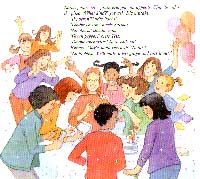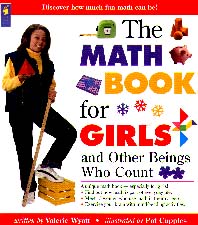|
________________
CM . . . .
Volume VII Number 15 . . . . March 30, 2001
excerpt: Cynthia Pollak thinks small - even smaller than Nora. Cynthia is a zoologist who studies spider webs. She knew that the silk connecting the "spokes' in the orb web was strong. But how strong?  Concerned about the appallingly low percentage (10%) of women in the scientific and engineering
workforce in Canada, the United States and Great Britain, Wyatt sets out, in this title, to build
girls' confidence in their mathematical ability, to relate math to the real world and to provide role
models in math-related careers. Wyatt enlists the help of Nora (short for Natural Observation
Research Activator), a pen-sized fairy godmother, who encourages readers to think about math
concepts and provides fun and easy experiments which are designed to spark interest and
reinforce the concepts presented.
Concerned about the appallingly low percentage (10%) of women in the scientific and engineering
workforce in Canada, the United States and Great Britain, Wyatt sets out, in this title, to build
girls' confidence in their mathematical ability, to relate math to the real world and to provide role
models in math-related careers. Wyatt enlists the help of Nora (short for Natural Observation
Research Activator), a pen-sized fairy godmother, who encourages readers to think about math
concepts and provides fun and easy experiments which are designed to spark interest and
reinforce the concepts presented.
The book is divided into four large sections, each having several sub-headings. Topics include various types of measurement, patterns, codes, symmetry, mapping and graphing. Every day tasks requiring math, such as drawing and baking, are also highlighted. What makes this book particularly appealing is the author's way of tying each theme together. For example, in the section entitled "Party Math," readers can use a variety of math activities to plan a birthday party from start to finish, with ideas ranging from tessellations wrapping paper to party games requiring skills in probability. Framed boxes, entitled "Real Life Math," appear frequently in the book. They feature 15 women who work in math-related professions, including a financial adviser, a cryptanalyst, a landscape architect, a veterinarian and a fabric designer. Colourful, cartoon-like illustrations complement the text and the fun approach of the book. A table of contents, an index and a glossary are included, as well as the answers to calculations and notes offering additional suggestions for parents and teachers. A companion book to The Science Book for Girls and Other Intelligent Beings, this title is sure to be a hit. Highly Recommended. Gail Hamilton is a teacher-librarian at Bird's Hill School in East St. Paul, MB.
To comment on this title or this review, send mail to cm@umanitoba.ca.
Copyright © the Manitoba Library Association.
Reproduction for personal use is permitted only if this copyright notice
is maintained. Any other reproduction is prohibited without
permission.
Published by
TABLE OF CONTENTS FOR THIS ISSUE - March 30, 2001.
AUTHORS |
TITLES |
MEDIA REVIEWS |
PROFILES |
BACK ISSUES |
SEARCH |
ORDER |
CMARCHIVE |
HOME
|
